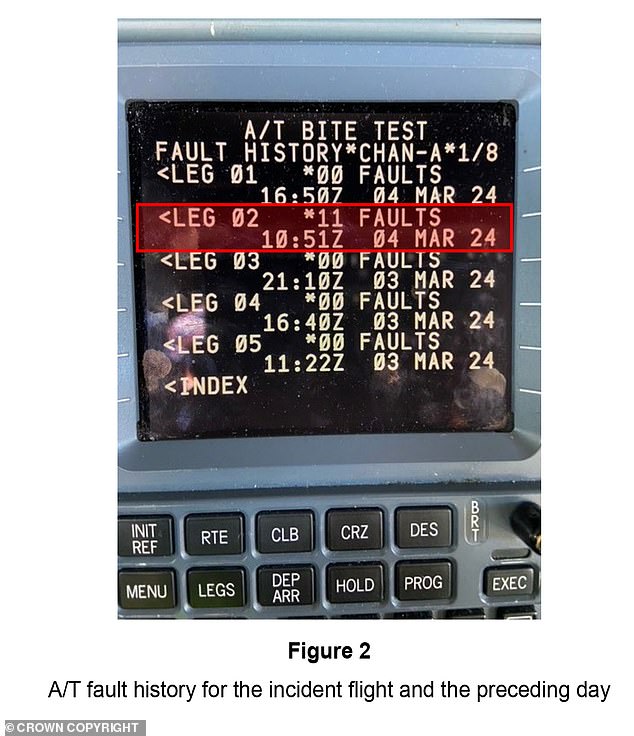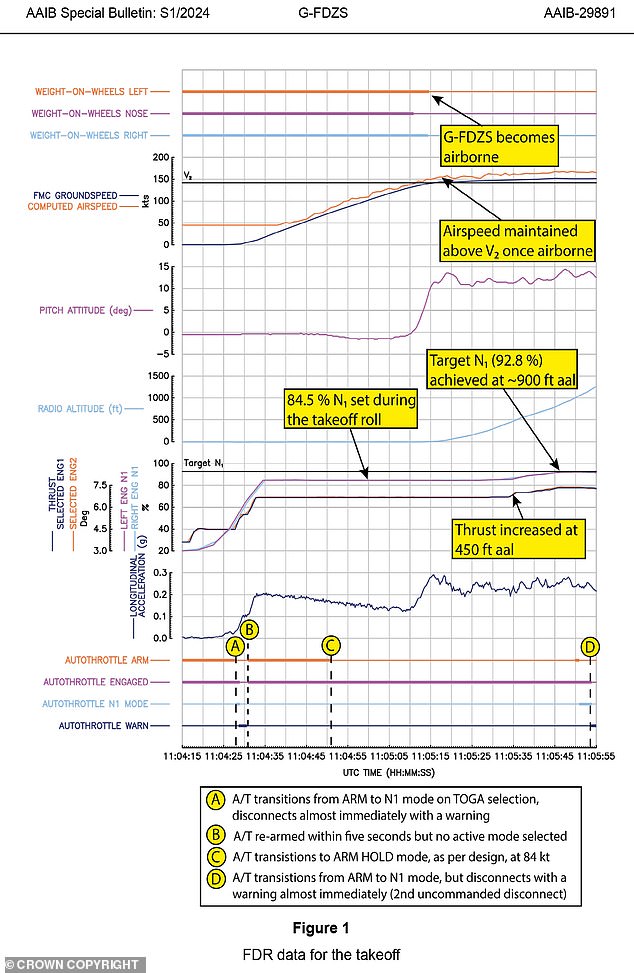Three seconds from disaster: How Boeing 737 flight from Bristol to Gran Canaria with 163 passengers on board cleared runway by just ten feet and narrowly passed over nearby A-road after software glitch
A passenger plane carrying 163 passengers and nine crew was just three meters from the end of a runway after a software error caused it to take off with insufficient power.
The TUI Boeing 737-800 was taking off from Bristol Airport’s 2.5km runway 9 to Gran Canaria on March 4 when it struggled to take off.
The 15-year-old plane took off with only 800 feet of runway left, clearing the end of the tarmac at a height of just 10 feet. The vehicle then passed over the nearby A38, less than 30 meters away.
When the plane’s wheels finally left the ground, it was flying at a speed of about 150 knots, meaning it would have left the runway less than three seconds later.
The Department of Transport’s Air Accidents Investigation Branch is investigating the incident, which it described as ‘serious’. They have issued a special warning to airlines using the next-generation Boeing 737-800 series about the software problem that compromised the safety of the flight.
According to the report, Boeing was aware of the software glitch before the incident, which saw the plane struggle to get airborne.
According to the AAIB report: ‘A Boeing 737-800 completed a take-off from runway 09 at Bristol Airport with insufficient thrust to meet regulated performance.’
Aviation experts recognize that planes that take off with insufficient thrust are at risk of stalling and crashing to the ground.
The Tui Boeing 737-800, pictured, only cleared the end of the runway at a height of 3 meters and passed the A38 by less than 30 meters as it lurched into the air due to a software error that selected an ‘insufficient thrust’ setting

The plane’s flight management computer recorded 11 errors with the plane’s autothrottle system

The Air Accident Investigation Branch’s preliminary investigation found that the aircraft’s acceleration performance was significantly worse than that of other aircraft. The two red lines on the map show the average performance of 99.7 percent of the other B737s at Bristol Airport
The report states that the aircraft’s autothrottle system was disabled when the crew selected take-off mode. Instead of the required 92.8% thrust needed to take off safely, the aircraft lurched down the runway at only 84.5%.
Neither pilot noticed the potentially fatal lack of power needed to take off safely.
An overview of the problems on the affected flight revealed eleven errors; many of these were related to the aircraft’s autothrottle system.
The data showed that the system, which is designed to reduce flight crew workload, was disabled twice during the flight.
Performance data collected by the AAIB, comparing the flight with other takeoffs from Bristol Airport, showed that its acceleration was significantly slower than that of 99.7 percent of other aircraft of the same model leaving the same airport.
According to the AAIB, the autothrottle system on a Boeing 737-800 can control thrust from takeoff to landing.
Investigators asked Boeing about their autothrottle system, but they admitted they were aware of a “long history of nuisance interruptions during takeoff.”

The AAIB was able to download the black box of the plane’s Flight Data Recorder, which showed how poorly the plane performed during takeoff
However, when these disconnects are investigated, “subsequent functionality checks of the system usually find no errors.”
Boeing said previous versions of the system could disconnect when the flight crew pressed a button during their normal take-off procedure.
According to the AAIB report: ‘The manufacturer recommends that all operators of the 737NG affected by these outages retrofit their aircraft with the newer model ASM (autothrottle servo motor) and associated Flight Control Computer software.
The AAIB report said the plane’s cockpit voice recorder only recorded the last two hours of the flight, so what was said between the two pilots was erased and overwritten by the time they arrived at Las Palmas airport.
However, investigators were able to track down the Flight Data Recorder – the Black Box – which provided them with vital performance data from the aircraft.
This incident is the latest in a series of worrying safety problems that have plagued Boeing aircraft over the past decade.
Federal prosecutors are considering suing the manufacturer over claims has violated a settlement that allowed the company to avoid criminal charges following two fatal crashes involving its 737 Max aircraft more than five years ago.
Last month, the U.S. Department of Justice told a federal judge about the possible breach.
It is now up to the Department of Justice (DOJ) to decide whether to file charges against Boeing. Prosecutors will tell the court no later than today how they plan to proceed, the ministry said.
New 737 Max jets crashed in Indonesia in 2018 and Ethiopia in 2019, killing 346 people. Boeing reached a £1.97 billion settlement with the Justice Department in January 2021 to avoid prosecution on a single charge of fraud – misleading federal regulators who had approved the plane. Boeing blamed two relatively low-level employees.
In a letter filed last month in federal court in Texas, Glenn Leon, head of the Justice Department’s fraud division, said Boeing violated the terms of the settlement by failing to implement promised changes to address violations of federal anti-fraud laws detect and prevent. .
The finding means Boeing could be prosecuted “for any federal criminal violation of which the United States is aware,” including the fraud allegation the company hoped to avoid with the settlement, the Justice Department said.
However, it is not clear whether the government will prosecute Boeing.
“The government will determine how it will proceed in this case,” the Ministry of Justice said in the court document.
Boeing has until June 13 to respond to the government’s allegations, and the department said it will consider the company’s explanation “in determining whether to pursue charges.”
Boeing Co, based in Arlington, Virginia, disputed the Justice Department’s findings.
“We believe we have complied with the terms of that agreement and look forward to the opportunity to respond to this matter with the Department,” a Boeing spokesperson said in a statement.
“As we do this, we will work with the Department with the utmost transparency, as we have throughout the life of the agreement, including in response to their questions following the Alaska Airlines 1282 accident.”
Boeing has been under renewed scrutiny since the Alaska Airlines flight in January, when a door plug blew out of a 737 Max, leaving a gaping hole in the side of the plane.
The company is conducting several investigations into the blowout and the quality of production. The FBI has told passengers on the flight that they may be victims of a crime.
Prosecutors said they will meet on May 31 with families of passengers killed in the two Max crashes. Family members were angry and disappointed after a similar meeting last month.
Paul Cassell, an attorney representing families of passengers in the second crash, said the Justice Department’s determination that Boeing violated settlement terms is “a positive first step that will be a long time coming.”
Investigations into the crashes pointed to a flight control system that Boeing added to the Max without notifying pilots or airlines. Boeing downplayed the system’s significance and only revised it after the second crash.
After secret negotiations, the government agreed not to prosecute Boeing on charges of defrauding the United States by misleading regulators about the flight system.
The settlement included a £192.4 million fine, a £395 million victim compensation fund and almost £1.4 billion to airlines whose Max jets were grounded for almost two years.
Boeing has faced civil lawsuits, congressional investigations and massive damage to its operations since the crashes in Indonesia and Ethiopia.
The manufacturer’s outgoing CEO, Dave Calhoun, will testify before a U.S. Senate panel later this month to answer questions about safety and production issues at the aircraft manufacturer.
The June 18 appearance before the Senate Permanent Subcommittee on Investigations follows an April hearing in which four whistleblowers alleged safety problems in the production of three of the four commercial aircraft currently produced by Boeing – the 737 MAX, the 787 Dreamliner and the 777.
“I look forward to Mr. Calhoun’s testimony, which is a necessary step in meaningfully addressing Boeing’s failures, regaining public trust, and restoring the company’s central role in the U.S. economy and national defense,” said Democratic Senator Richard Blumenthal, chairman of the subcommittee. .
A TUI spokesperson told MailOnline: ‘We have worked closely with the authorities to provide all available information. The AAIB recommendations and lessons learned from this launch will support the entire aviation sector and other airlines.
“The safety of our passengers and crew is always our top priority.”
MailOnline has contacted the Air Accident Investigation Branch (AAIB) and Boeing for comment on this latest incident.
